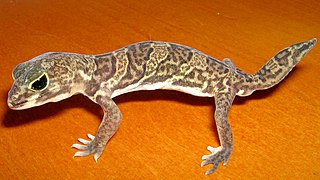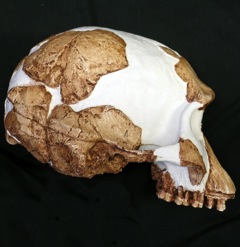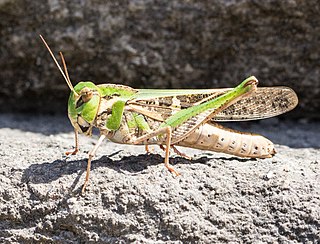
Australopithecus is a genus of early hominins that existed in Africa during the Late Pliocene and Early Pleistocene. The genus Homo emerged within Australopithecus, as sister to e.g. Australopithecus sediba. Also the genera Paranthropus and Kenyanthropus emerged within Australopithecus. Australopithecus is a member of the subtribe Australopithecina, which sometimes also includes Ardipithecus, though the term "australopithecine" is sometimes used to refer only to members of Australopithecus. Species include A. garhi, A. africanus, A. sediba, A. afarensis, A. anamensis, A. bahrelghazali and A. deyiremeda. Debate exists as to whether some Australopithecus species should be reclassified into new genera, or if Paranthropus and Kenyanthropus are synonymous with Australopithecus, in part because of the taxonomic inconsistency.

Gehyra is a genus of geckos in the family Gekkonidae. They are known as web-toed geckos or dtellas, and most species within the genus bear close resemblance to geckos from the genus Hemidactylus.

Gonatodes is a genus of New World dwarf geckos of the family Sphaerodactylidae.

Hemidactylus is a genus of the common gecko family, Gekkonidae. It has 189 described species, newfound ones being described every few years. These geckos are found in all the tropical regions of the world, extending into the subtropical parts of Africa and Europe. They excel in colonizing oceanic islands by rafting on flotsam, and are for example found across most of Polynesia. In some archipelagoes, cryptic species complexes are found. Geckos like to live in and out of houses. They have been introduced to Australia.

Pseudogonatodes is a genus of sphaerodactylid geckos, often known as South American clawed geckos, containing seven described species. Like most sphaerodactylines, Pseudogonatodes are miniaturized geckos and among the smallest living lizards. They are diurnal and terrestrial, foraging among leaf litter and rotting wood on the ground. Prey items are primarily small arthropods such as springtails, insect larvae, and orthopterans. Though locally common and not strongly threatened with extinction, most species occupy restricted ranges in remote tropical forests. The most widespread and well-studied species, Pseudogonatodes guianensis, is found throughout the Amazon rainforest.

Ptenopus is a small genus of lizards, known commonly as barking geckos, in the family Gekkonidae. The genus is endemic to southern Africa. There are only three described species in this genus.

Ptyodactylus is a genus of geckos, which are commonly known as fan-fingered geckos. The genus has 12 described species.

The African wild ass or African wild donkey is a wild member of the horse family, Equidae. This species is thought to be the ancestor of the domestic donkey, which is sometimes placed within the same species. They live in the deserts and other arid areas of the Horn of Africa, in Eritrea, Ethiopia and Somalia. It formerly had a wider range north and west into Sudan, Egypt, and Libya. It is Critically Endangered, with about 570 individuals existing in the wild.

Soemmerring's gazelle, also known as the Abyssinian mohr, is a gazelle species native to the Horn of Africa. The species was described and given its binomen by German physician Philipp Jakob Cretzschmar in 1828. Three subspecies are recognized. It is possibly no longer present in Sudan.
Gryponyx is an extinct genus of massopod sauropodomorph known from southern Free State, central South Africa.

The richness and variety of the wildlife of Ethiopia is dictated by the great diversity of terrain with wide variations in climate, soils, natural vegetation and settlement patterns. Ethiopia contains a vast highland complex of mountains and dissected plateaus divided by the Great Rift Valley, which runs generally southwest to northeast and is surrounded by lowlands, steppes, or semi-desert.

The double-banded courser, also known as the two-banded courser, is a species of bird in the family Glareolidae.

Holodactylus africanus, also known as the African clawed gecko, Boettger's strong-clawed gecko, or African whole-toed gecko, is a species of gecko that is commonly found in Eastern Africa. The gecko has a big head, thin body, stumpy tail, and has tan and brown bands. The adults are 3 and a half to four inches long.

The Ethiopian xeric grasslands and shrublands ecoregion is a semi-desert strip on or near the Red Sea and the Gulf of Aden coasts in Eritrea, Ethiopia, Djibouti and Somaliland. This ecoregion lies mainly between sea level and 800 meters (m) elevation. There are, however, many hills and massifs, which range up to 1300 m as well as outstanding fault-induced depressions, such as the Danakil, lying as low as 155 m below sea level. This region is extremely active tectonically, experiencing many earthquakes and intermittently active volcanoes. Rainfall is very low and yearly averages range from 100 to 200 millimeters (mm), with less rain falling closer to the coast. There are many species of interest, including the endemic Archer's lark, a species of dragon tree, and a large suite of desert ungulates, including the last viable population of African wild ass.
H. africanus may refer to:

Homo gautengensis is a species name proposed by anthropologist Darren Curnoe in 2010 for South African hominin fossils otherwise attributed to H. habilis, H. ergaster, or, in some cases, Australopithecus or Paranthropus. The fossils assigned to the species by Curnoe cover a vast temporal range, from about 1.8 million years ago to potentially as late as 0.8 million years ago, meaning that if the species is considered valid, H. gautengensis would be both one of the earliest and one of the longest lived species of Homo.

Holodactylus cornii, also known as the East African clawed gecko, is a species of gecko that is commonly found in Eastern Africa.

Gastrimargus is a genus of grasshoppers in the subfamily Oedipodinae. The recorded distribution of species in this genus includes Africa, Asia, and Oceania.
Ancylodactylus is a genus of diurnal (day) geckos in the family Gekkonidae. The genus is endemic to Africa. Most of the species in the genus Ancyclodactylus were formerly assigned to the genus Cnemaspis.
















